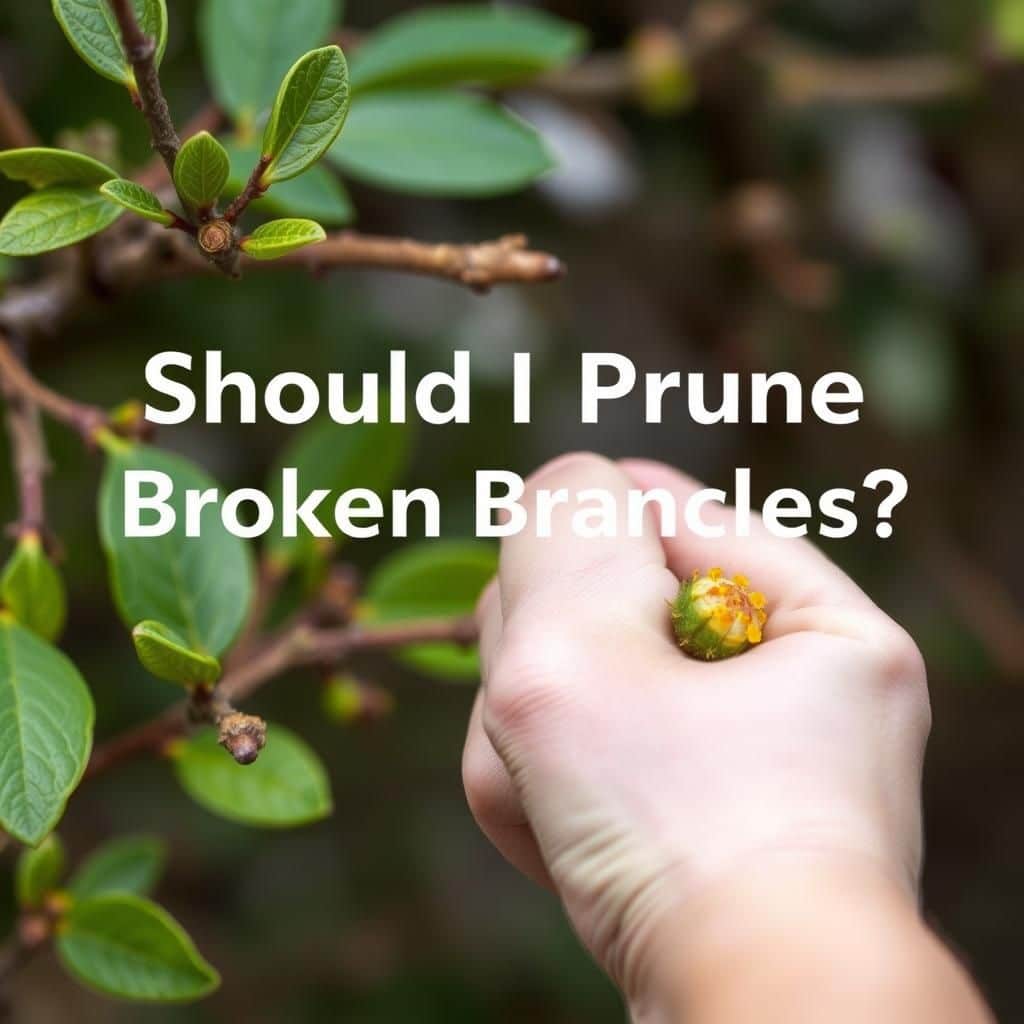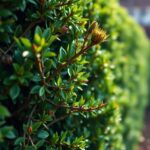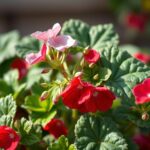Should I Prune Broken Branches? Essential Tips for Garden Health

Maintaining a healthy garden requires regular attention, and one of the essential tasks is pruning broken branches. Whether caused by severe weather, pests, or disease, these damaged limbs can pose risks to the overall health of your plants. While it may be tempting to leave them be, timely and proper pruning can prevent further harm and encourage new growth. This article will explore the importance of removing broken branches, the best techniques for doing so, and essential tips to ensure your garden thrives. Understanding the right approach can make all the difference in promoting a lush and vibrant outdoor space.
Should I Prune Broken Branches?
Pruning broken branches is essential for maintaining the overall health and vitality of your plants and trees. When a branch is broken, it may expose the inner tissues to diseases and pests, leading to further damage. By promptly removing broken branches, you can help prevent the spread of infection and encourage proper healing of the plant. Additionally, pruning can improve airflow and light penetration within the canopy, promoting healthier growth. However, it is important to use proper techniques and tools to ensure that the pruning is carried out effectively and does not cause additional harm to the plant.
Benefits of Pruning Broken Branches
Pruning broken branches offers several benefits that contribute to the health of the plant. Firstly, it helps to prevent the spread of diseases and pests that may enter through the wounded area. Secondly, removing broken branches can promote better air circulation and light exposure, which are vital for photosynthesis and overall plant vigor. Lastly, it helps maintain the desired shape of the plant, making it more aesthetically pleasing while ensuring that resources are being directed toward healthy, vigorous growth.
When to Prune Broken Branches
The ideal time to prune broken branches is during the dormant season for most trees, typically in late winter or early spring before new growth begins. Pruning during dormancy minimizes stress on the plant and allows for quicker recovery once the growing season kicks in. However, if a branch is severely damaged and poses a risk to safety or has the potential to introduce disease, it should be removed immediately regardless of the season.
How to Properly Prune Broken Branches
Proper pruning techniques are crucial to ensure the health of the plant. Begin by using clean, sharp tools such as pruning shears or a saw to make a clean cut just above a healthy bud or branch junction. Avoid tearing the bark, as this can lead to infection. Additionally, it's advisable to make cuts at a slight angle to allow water to run off, preventing rot. Always disinfect your tools before and after use to minimize the risk of transmitting diseases between plants.
Risks of Not Pruning Broken Branches
Neglecting to prune broken branches can lead to numerous risks for your plants. Broken branches can become entry points for pests and disease, which can infect the entire plant and potentially spread to nearby plants. Additionally, dead or broken branches may weaken the overall structure of the plant, leading to further breakage or even collapse during storms or high winds. Lastly, the presence of broken branches can also attract unwanted wildlife, increasing the risk of damage to your garden.
Tools Needed for Pruning
Having the right tools makes the pruning process more efficient and safe. Essential tools include pruning shears for small branches, a lopper for thicker limbs, and a handsaw for larger branches. It is also important to have a pair of gloves for protection and safety goggles to shield your eyes from flying debris. Keeping these tools well-maintained and sharp will help make clean cuts and reduce the risk of injuring both yourself and the plant.
| Tool | Use |
|---|---|
| Pruning Shears | For cutting small branches |
| Lopper | For thicker limbs |
| Handsaw | For large branches |
| Gloves | For protection |
| Safety Goggles | To shield eyes from debris |
Should you cut a broken branch?

Should You Cut a Broken Branch?
In general, it is advisable to cut a broken branch, particularly if it poses a threat to the health of the tree or if it could be a hazard to nearby structures or people. Broken branches not only affect the aesthetics of a tree but can also lead to disease or infestation. Here are some reasons and considerations regarding cutting a broken branch.
Reasons to Cut a Broken Branch
Cutting a broken branch can prevent further damage and promote the health of the tree. Here are some reasons to consider:
See also:
- Prevent Disease: Broken branches can expose the tree to infections and pests.
- Safety Hazards: A broken branch may fall unexpectedly, posing risks to people and property.
- Tree Health: Removing damaged branches allows the tree to redirect nutrients to healthier parts, promoting growth and vitality.
Safety Precautions When Cutting
When deciding to cut a broken branch, it's crucial to follow safety precautions to mitigate risks.
- Use Proper Tools: Always use sharp, clean tools like pruning shears or a saw for clean cuts.
- Wear Protective Gear: Safety goggles and gloves protect against injury from falling branches or sharp tools.
- Assess the Surroundings: Ensure the area beneath the branch is clear of people or obstacles before making any cuts.
When to Cut vs. When to Leave Alone
Determining whether to cut a broken branch can depend on various factors that assess the situation properly:
- Extent of Damage: If the branch is severely damaged and hanging loosely, it’s best to cut it.
- Location: If the branch is near power lines or a building, immediate action is necessary.
- Tree Type: Some trees are more vulnerable to damage; consider the species and its health before decision-making.
How to Cut a Broken Branch Properly
Knowing how to cut a broken branch correctly ensures minimal harm to the tree. The following steps can help:
- Make the Initial Cut: Start with an undercut a few inches away from the trunk or main stem about one-third of the way through the branch.
- Complete the Cut: Move a few inches further along the branch and cut from the top down to remove the weight on the branch.
- Clean Up the Wound: Trim any jagged edges to help the tree heal more effectively and apply a sealant if necessary.
Aftercare for the Tree
After cutting a broken branch, providing appropriate aftercare can help the tree recover effectively:
- Watering: Ensure the tree receives adequate water to promote healing.
- Monitoring Health: Keep an eye on the tree for any signs of disease or distress after cutting.
- Fertilization: Consider applying fertilizer to support new growth and strengthen the tree.
What is the 123 rule of pruning?

The 123 rule of pruning is a straightforward guideline used in horticulture to assist gardeners and landscapers in determining how to prune shrubs and trees effectively. By following the rule, individuals can enhance the health and appearance of plants while simultaneously promoting growth and flowering. The principle ensures that the pruning process is not overwhelming and provides a clear direction for both novice and experienced pruners.
What is the 123 Rule?
The 123 rule refers to a simple method for pruning that consists of three main steps:
- One Cut: Make a single, strategic cut to remove a branch that is crossing or rubbing against another, thus preventing injury to the plant.
- Two Cuts: Remove any two branches that create excessive crowding; this helps improve air circulation and light penetration within the foliage.
- Three Cuts: For more complex structures, take three cuts to shape the plant. This includes a superficial cut, deeper cut to remove the main branch, and another to clean up the surface of the cut.
Benefits of Following the 123 Rule
Applying the 123 rule can lead to numerous benefits for plant health and growth:
- Improved Health: Proper pruning reduces the risk of disease by getting rid of dead or damaged branches.
- Enhanced Growth: By selectively removing branches, the plant directs its energy toward healthier growth.
- Better Appearance: This method helps maintain a balanced shape, making the plants more visually appealing.
When to Use the 123 Rule
The timing of pruning is crucial for the effectiveness of the 123 rule:
- Late Winter/Early Spring: Ideal for most deciduous trees and shrubs before the new growth begins.
- Summer Pruning: Useful for touch-ups to prevent overgrowth and maintain shape.
- Post-Bloom: Pruning flowering shrubs immediately after they bloom can promote new growth for the next season.
Common Mistakes to Avoid
Avoiding errors during pruning can make a significant difference in the outcome:
- Over-Pruning: Removing too much foliage can stress the plant and hinder growth.
- Poor Timing: Pruning at the wrong time can damage or kill the plant; timing is essential.
- Improper Tools: Using dull or inappropriate tools can lead to jagged cuts that harm the plant.
Tools Needed for the 123 Rule
Using the right tools can ensure effective pruning with the 123 rule:
See also:
- Bypass Pruners: Great for making clean, precise cuts on smaller branches.
- Loppers: Ideal for thicker branches that cannot be cut with standard pruners.
- Saws: Necessary for larger limbs and for achieving a smooth cut without damaging the plant.
How to treat a broken branch?

To treat a broken branch effectively, it’s essential to follow a series of steps that can help heal the tree and minimize damage. A broken branch can expose the tree to pests, disease, and further stress, so addressing the issue promptly is crucial. Here are detailed steps to treat a broken branch:
Assess the Damage
Assessing the damage is the first step in treating a broken branch. Look at the extent of the break to determine the best course of action.
- Check if the break is clean or jagged.
- Look for any bark damage surrounding the break.
- Determine whether the branch is partially attached or completely broken off.
Prune the Broken Branch
Pruning is a vital step in treating a broken branch. Proper pruning helps the tree to focus on healing.
- Use sharp and sterilized pruning shears to make a clean cut.
- Cut at a slight angle just above a healthy bud or lateral branch.
- Avoid leaving a stub, as this can lead to decay.
Apply Wound Dressing
Using a wound dressing can aid in protecting the cut area. Although some experts debate its necessity, it can be beneficial in certain circumstances.
- Choose a commercially available tree wound dressing.
- Apply the dressing to the cut surface lightly.
- Do not over-apply, as it needs to breathe to heal properly.
Monitor Tree Health
After treating the broken branch, it’s important to keep an eye on the overall health of the tree.
- Look for signs of new growth around the cut area.
- Check for any signs of infection or pests.
- Ensure the tree is receiving adequate water and nutrients.
Prevent Future Breaks
To prevent future breaks, proactive measures should be taken.
- Regularly prune and maintain branches to promote healthy growth.
- Ensure the tree is not overloaded with fruit or leaves.
- Provide adequate support to weaker branches during storms or heavy winds.
Questions from Our Readers
Should I prune broken branches?
Yes, you should prune broken branches to promote the overall health of your plant. Removing these branches helps to prevent disease and allows the plant to focus its energy on new growth.
When is the best time to prune broken branches?
The best time to prune broken branches is during the dormancy period of the plant, which usually occurs in late winter or early spring. This timing minimizes stress to the plant and helps it recover more effectively.
How should I prune broken branches?
When pruning broken branches, use clean and sharp tools to make a clean cut just above a healthy bud or branch junction. This ensures a proper healing process and reduces the risk of injury to the remaining parts of the plant.
Will pruning broken branches harm my plant?
While pruning broken branches can initially seem harmful, it is often beneficial for the long-term health of the plant. By removing damaged areas, you encourage better air circulation and reduce the chance of diseases spreading.
See also:

If you want to read more articles like Should I Prune Broken Branches? Essential Tips for Garden Health, we recommend you check out our Pruning category.
Leave a Reply
Related Articles